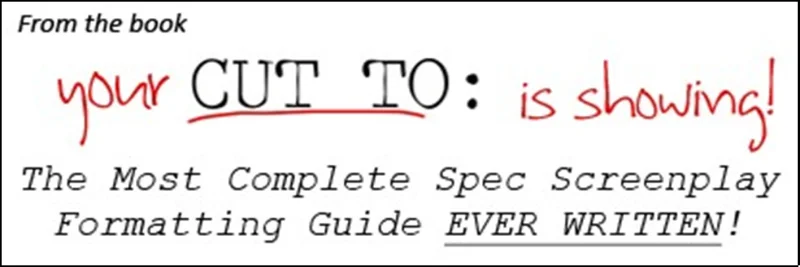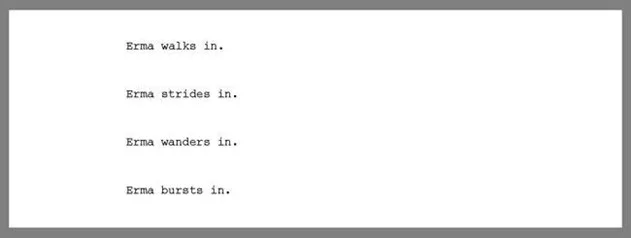
Screenwriting ABCs Script Formatting
Direction Writing Tips: Part 1
by T. J. Alex
Book Excerpt, 5 pages
Viewed by: 39 Residents and 200 Guests

Direction Writing Tips: Part 1
My book is a screenplay formatting guide, not a screenplay writing guide, so I won't go into lots of detail with regards to the art of screenplay writing. However, I do want to give some very basic tips that might help writers where writing is concerned.
Present Tense:
All screenplays are written in Present Tense. The following example, then, is incorrect:

The example above is written in Past Tense. Here is how it should be written:

Much better.
Another big mistake writer's will make in their writing is the mixing of tenses. Usually my clients write in Present Tense without a problem, but for some reason, briefly lapse into the Past Tense without realizing it. Here is an example.

Writing "wasn't" instead of "isn't" is a very easy mistake to make and happens more often than you'd think. I'll probably find one to two mixed-tense errors every time I edit a screenplay.
Active vs. Passive Voice:
Screenplays should be written in Active Voice rather than Passive Voice. Passive almost always leads to poor verb usage, requires more words to write, and takes the action away from the subject of the action.
Below are two examples of Passive Voice:

Here are the same examples, written in the Active Voice:

Much better. The verbs are more vibrant by default, the writing is tighter as fewer words were used, and the subjects of the action are moved to the front of the sentence where they belong.
Avoid "To Be" Verbs:
"To be" verbs are weak verbs like "is," "are," "was," and "were." They need to be avoided as much as humanly possible. Many times these verbs will precede an "ing" verb, further weakening the writing. Here are some examples of writing made bad with the use of "to be" verbs:

The verbs "walk," "laugh," and "smoke" are weak and generic verbs to begin with. Couple them with the "to be" verb "is" and the "ing," and they go from weak to atrocious.
Here are the same examples with the "to be" verb taken away:

The verbs are still weak and generic, but worlds better. With my clients, this is easily one of the biggest writing errors I find. With some clients, I'll scratch out the "is" and "ing" literally hundreds of times in a single script in hopes they'll opt for the slightly better alternative.
Preferably, though, I wish they'd recognize a weak and generic verb when they see them and try to find better alternatives that compliment the subject of the action. After all, a good thesaurus is usually just a few internet clicks away.
Below are the same sentences but with some more exciting alternatives to the generic counterparts:

The examples above are not rocket science, but they are better than their earlier equivalents.
Anyone can walk down a sidewalk. But only those with confidence will strut down a sidewalk. Someone creeping down a sidewalk might appear more menacing than someone who walks down it. And a person inching down the sidewalk would seem to do so slowly, methodically, and/or cautiously.
In the next example, each verb adds to just how hard Cecilia laughs and better cues an actor on how the scene should be played.
In the third example, maybe we have Walter puff on the cigarette, something he could do without even inhaling. But if he sucks on a cigarette, he'll be inhaling the smoke deeply. Lastly, if the cigarette simply dangles from his lips, he's not really smoking it at all. Perhaps he's too lost in the want ads to care about the cigarette. Either way, the verb used greatly changes the feel of the scene.
Verbs and Character:
The point I'm trying to make above is that a verb should say something about a character. Any character can walk into a room. Ask yourself exactly how YOUR character would walk into a room. Did your character sit in a chair, or did they melt into the chair?
The best writers leave nothing to chance, and make sure every verb compliments the person doing the action. It shows the reader that the writer really knows his characters and their emotions.
Here is another example:

In the first example we know that she sits in the chair. But in the next example we are told HOW she sits in the chair. It says something about her condition.
Look at this one:

Anyone can "hold" a gun. Only certain people in certain situations will "clutch" the gun. Completely different people will "cradle" a gun. It all depends on the character.
Let's look at one more:

We can do away with the extremely generic and overused verb "walk" and replace it with something that addresses emotional state. Again, none of them are outstanding verbs, but they are all far better than "walk," and each says something about the character performing the action.
Avoid Adverbs:
Adverbs are words that modify verbs (or sometimes adjectives) and usually end in "ly." In screenplay writing, adverbs work to emphasize verbs that are probably already too weak to begin with. Here are a few examples with adverbs:

The examples are not necessarily wrong, they are just weak. Whether than use adverbs to show that the opponent is beaten quickly, that Ralph easily jumps the fence, or how the crowd cheers, why not do away with the adverb and find a single, more exciting, verb to better convey the information. Consider these examples:

When a writer is in the re-writing phase, he/she should go through the screenplay and circle EVERY verb in Direction, and decide if there is a better way to say the same thing.
-------------------------
For more screenplay formatting rules and advice, check out the book, Your CUT TO: Is Showing! by T. J. Alex or visit www.scripttoolbox.com. From there, please like the page on Facebook, and share it with your friends.
If you have any formatting questions, please email T. J. at tj@tjalex.com.




